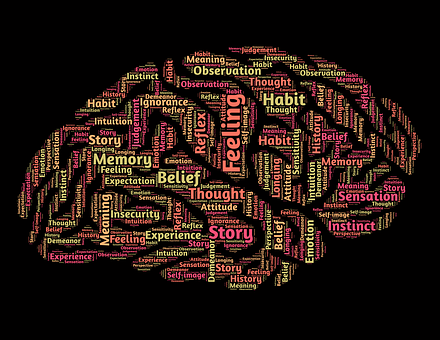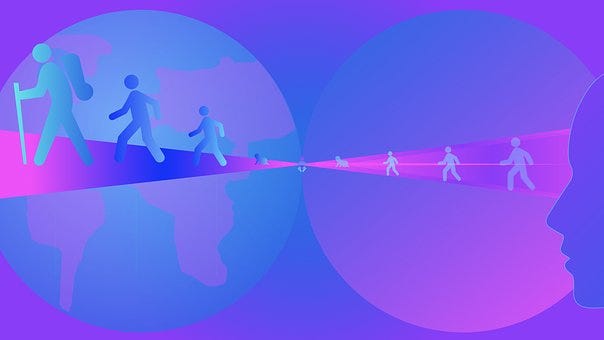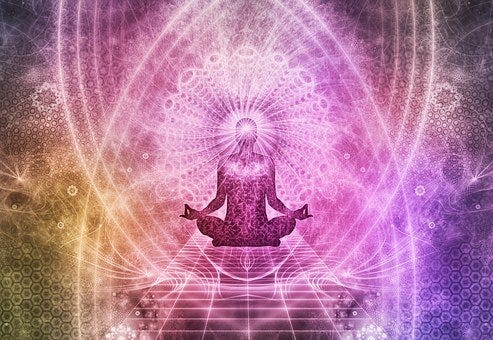
This article is part of a series discussing the Hard Problem of consciousness — how is it possible that a material brain can give rise to subjective experience, a sense of self? It follows on from an introduction, and a second article which discussed the philosophical concept of dualism — the idea that consciousness and matter are of a fundamentally different nature — which some offer as a solution to the problem. It is, however, rejected by the majority of modern neuroscientists and philosophers. These two articles have prepared the way for the following discussion of a spiritual understanding of consciousness. I submit that this viewpoint solves the so-called Hard Problem. Unfortunately, however, it cannot be proved, and obviously falls outside the scope of scientific investigation. It will consequently be rejected, even ridiculed, by materialist neuroscientists.
Philip Goff, the philosopher whose book Galileo’s Error I discussed in the preceding articles, says that neuroscience has not come up with a solution to the Hard Problem; it has “thus far failed to provide even the beginnings of an explanation” (p5). He finds this strange considering the great progress that has been made by science in other areas. All science can offer us is promissory materialism, that if we wait long enough, a solution will be discovered at some remote time in the future.
If a problem appears completely insoluble, however, at some point someone is surely going to wonder whether the wrong question is being asked. Question: how does the brain generate consciousness, subjective experience? Answer: perhaps it doesn’t. After all, no one has ever proved that consciousness is an epiphenomenon of the brain. This is merely an assumption, based on an acceptance of the Standard Model of modern science: the Big Bang (therefore the primacy of matter), the mysterious emergence of organisms from inorganic matter, the evolution of organisms to more complex forms, ultimately including brains and nervous systems without self-consciousness, then finally self-awareness.
Such scientists are merely trying to prove, unsuccessfully as it turns out, what they want to be true.
In order to address the question of consciousness, it is necessary to have a true understanding of what it is to be a human being. I submit that materialist science does not, and will never, have this, and we therefore need an alternative perspective. We can find this in spiritual traditions, where a human being exists as a hierarchy, at different levels, usually numbered at seven. Here I’ll describe two versions of such systems.
The first is that of the late Raynor C. Johnson whom I consider to be an authority on spiritual matters. (If you would like to understand the strange background story which led me to do so, and more details about him, click here.) He is eclectic, and seems to be unattached, not obviously a follower of any particular tradition, but has a deep understanding of them. He is also interested in the paranormal, and Jungian psychology including dream interpretation. Here is his understanding of the nature of a human being, taken from his book The Spiritual Path¹ (all quotes, chapter 2).
He says that there are at least six levels, plus a seventh level of spirit which he places above human nature. These are soul “which is of the nature of spiritual reality”, the “immortal element”, and a “Being of Light”, and five bodies which clothe it: causal, mental, astral, etheric, and physical. Each of these bodies exists within a different level of reality, and “each body may be regarded as created by, or precipitated from, the one higher above it”. “Each level is therefore a partial reflection or imperfect representation of the level above it”:
- the causal body “belongs to a level that inspires all the highest forms”
- the mental body refers to “the many lower levels of mind”, “a busy telephone exchange on the middle floor of a three story building”
- the astral body, which “is itself composed of many substrata or interpenetrating levels”, “to a considerable degree the expression of our emotional interests”
- the etheric double, which is “interposed between the astral and physical bodies. It is not a functional body or vehicle, but it may best be regarded as a bridge between the physical and astral bodies. It is, however, sometimes called the vital body”. “During the life of the physical body, this etheric structure never wholly withdraws from it, but tries to maintain the health of the nervous system”
- the physical body, which needs no explanation.
The second version is the understanding of the Theosophical Society, founded by Helena Blavatsky². The society offers a synthesis of Eastern and Western ideas, and describes a sevenfold constitution of a human being, where each of these principles (what Johnson calls bodies) is embodied in a person:
- Spirit or Self, “pure consciousness, the cosmic self that is the same in everyone in the universe. It’s the feeling and knowledge of ‘I am’, pure cognition, or the abstract idea of self”
- a Spiritual Soul principle — vehicle of pure universal spirit
- a mind level, subdivided into the spiritual or higher Ego, and the lower or ordinary mind
- emotion principle
- the vital principle, “pulsating during the entire term of physical life”, “an indispensable factor of the living man”
- the astral body, or double, “slightly more ethereal than the physical body”
- the physical body.

Despite the slight differences in terminology and positioning in the hierarchy, which need not concern us here, the two systems are very similar in their understanding. I submit that, whichever version we choose, we will have at the very least a close approximation to what it means to be human. If you find these models incredible or too far-fetched, at least contemplate the possibility that humans, in our everyday experience, are consciousnesses (souls) incarnated into bodies. The modern psychological theory that fits most closely with such ideas is called the Transmission Model, namely that the brain functions as an organ which limits or filters consciousness. ( I’ve discussed this in an earlier article, click here.)
There are two major implications for the current discussion. Firstly, despite what neuroscientists assume, consciousness is not an epiphenomenon of the brain, but is our ultimate, true nature. There is a level of our being at which we are pure consciousness, completely without personality or anything else associated with the lower levels, but where we nevertheless recognise ourselves as individuals, separate from other such beings. This is stated clearly in the top line of the second model above. (I personally choose to call this soul, but other terms are possible, for example monad.) That is why neuroscience will never be able to discover how the brain generates consciousness. As all the great religions teach, consciousness is the primary reality, and everything else is a manifestation of this Ultimate Consciousness. The true Hard Problem is therefore to understand how this Consciousness creates matter.
Secondly, a human being has a higher and lower nature. The lower nature we might call the personality, consisting of the ordinary mind, emotions, and body (biological drives and instincts). This is what our everyday consciousness experiences all the time; it is our reality. On the other hand, we do not experience our higher nature, consisting of spirit, soul, and higher mind; they are part of our unconscious psyche, but what meditation and other spiritual practices aspire to.
According to these models, the personality is what the soul acquires as it descends through these various levels; it is not something created by the brain, or even the genes, although it may seem like that to neuroscientists and biologists. It has to be remembered that all these bodies are not separate, in different places, but interpenetrate each other at levels of increasing density; they act as one, even though the higher levels usually remain unconscious. Since neuroscientists are not aware of these other bodies, and almost certainly don’t believe in their existence, they can easily misinterpret what they are seeing. The activity they see on their brain-scans may well be the effect of these higher, but invisible, bodies on the brain, not the brain as the source of thoughts, emotions etc.
The ideas outlined here, which suggest the philosophy of idealism, have been the viewpoint of Eastern religions, if not all religions, for thousands of years. And they are not some bizarre, unscientific notion, for idealism, or a close equivalent, is also increasingly the viewpoint of quantum physicists. I mentioned Fred Alan Wolf and Danah Zohar in the previous article. In earlier ones I have frequently quoted Werner Heisenberg, Sir James Jeans, Sir Arthur Eddington, and Max Planck. Also worthy of attention are David Bohm and his concepts of implicate and explicate orders, and Amit Goswami, whose book The Self-Aware Universe: How Consciousness Creates the Material Word³ is a wonderful synthesis of quantum physics and spiritual ideas. It is worth considering that, despite the frequent claims of modern scientists that ancient religious ideas have been relegated to the dustbin of history, these ideas may still be relevant today, offering solutions to problems that science cannot solve. It is true that the soul can never be part of science, but not because the soul doesn’t exist, rather because science can only deal with the material world, not being able to perform controlled experiments on immaterial entities. In the absence of any other coherent solution to the Hard Problem, why not at least take such ideas seriously?

Footnotes:
1. Hodder & Stoughton, 1972
2. What follows is taken from a handout from the Society.
3. Jeremy P. Tarcher/Putnam, 1995